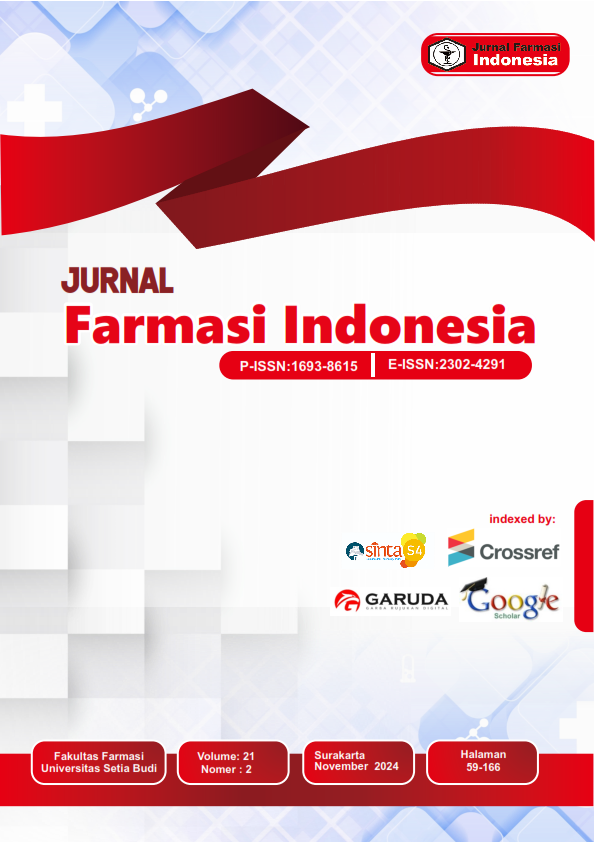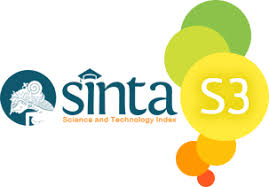Analysis of Reducing Agents in Red Bell Pepper and Large Green Chili (Capsicum annum L.) Using Spectrophotometric Method via Redox Reaction with Triiodide
Abstract
The determination of reducing compounds in plant samples is continuously developed to achieve more practical and efficient analytical methods. This study analyzed the reducing compound content in red bell peppers and large green chilies using UV-Vis spectrophotometry via a redox reaction with triiodide. The results showed that this method can effectively determine reducing compounds in plant samples. The large green chili sample contained 0.01723% reducing compounds, whereas the red bell pepper sample exhibited a higher content of 0.0267%. These findings indicate that red bell peppers have a higher concentration of reducing compounds than large green chilies. This method has the potential to be a reliable approach for analyzing reducing agents in plants and can be further developed for pharmaceutical and food analysis applications.
References
[2] A. Altemimi, N. Lakhssassi, A. Baharlouei, D. G. Watson, and D. A. Lightfoot, “Phytochemicals: Extraction, isolation, and identification of bioactive compounds from plant extracts,” Plants, vol. 6, no. 4, 2017, doi: 10.3390/plants6040042.
[3] R. E. Mutha, A. U. Tatiya, and S. J. Surana, “Flavonoids as natural phenolic compounds and their role in therapeutics: an overview,” Futur. J. Pharm. Sci., vol. 7, no. 1, 2021, doi: 10.1186/s43094-020-00161-8.
[4] J. SANG-HYUK, J.-W. YEON, Y. KANG, and K. SONG, “Determination of Triiodide Ion Concentration Using UV-Visible Spectrophotometry,” Asian J. Chem., vol. 26, no. 12, pp. 70–73, 2014.
[5] T. H. C. Marques, C. H. S. de Melo, and R. M. de Freitas, “In vitro evaluation of antioxidant, anxiolytic and antidepressant-like effects of the Bellis perennis extract,” Rev. Bras. Farmacogn., vol. 22, no. 5, pp. 1044–1052, 2012, doi: 10.1590/S0102-695X2012005000082.
[6] C. Chávez-Mendoza, E. Sanchez, E. Muñoz-Marquez, J. P. Sida-Arreola, and M. A. Flores-Cordova, “Bioactive compounds and antioxidant activity in different grafted varieties of bell pepper,” Antioxidants, vol. 4, no. 2, pp. 427–446, 2015, doi: 10.3390/antiox4020427.
[7] O. Bizerea-Spiridon et al., “Spectrophotometric determination of Selenium through triiodide anion,” Clin. Lab., vol. 63, no. 5–6, pp. 887–899, 2017, doi: 10.7754/Clin.Lab.2016.160905.
[8] B. Meyiwa, “Iodometric and Iodimetric Titration Methods,” J. Wet. Heal., vol. 1, no. 1, pp. 5–8, 2020, doi: 10.48173/jwh.v1i1.9.
[9] H. Sulistyarti, E. Sulistyo, S. Sutrisno, and Z. Rismiarti, “Metode Spektrofotometri Secara Tidak Langsung untuk Penentuan Merkuri(II) berdasarkan Pembentukan Kompleks Biru Iodium-Amilum,” ALCHEMY J. Penelit. Kim., vol. 15, no. 1, p. 149, 2019, doi: 10.20961/alchemy.15.1.15036.149-164.
[10] N. Li, L. Shi, X. Wang, F. Guo, and C. Yan, “Experimental Study of Closed System in the Chlorine Dioxide-Iodide-Sulfuric Acid Reaction by UV-Vis Spectrophotometric Method,” Int. J. Anal. Chem., vol. 2011, pp. 1–7, 2011, doi: 10.1155/2011/130102.
[11] C. Taiti, C. Costa, C. A. Migliori, D. Comparini, S. Figorilli, and S. Mancuso, “Correlation Between Volatile Compounds and Spiciness in Domesticated and Wild Fresh Chili Peppers,” Food Bioprocess Technol., vol. 12, no. 8, pp. 1366–1380, 2019, doi: 10.1007/s11947-019-02297-9.
[12] L. M. Anaya-Esparza, Z. V. de la Mora, O. Vázquez-Paulino, F. Ascencio, and A. Villarruel-López, “Bell peppers (Capsicum annum l.) losses and wastes: Source for food and pharmaceutical applications,” Molecules, vol. 26, no. 17, pp. 1–23, 2021, doi: 10.3390/molecules26175341.













